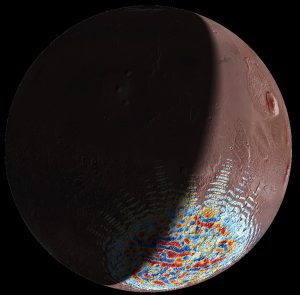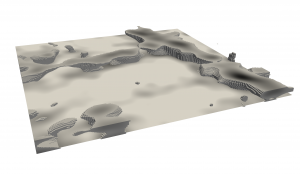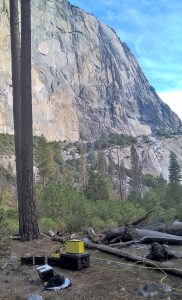Alain Plattner
Assistant Professor
- (205) 348-5095
- amplattner@ua.edu
- Bevill Building 2023
- Website
Education
- PhD, Computational Geophysics, ETH Zürich (Switzerland), 2011
- MS, Mathematics, University of Basel (Switzerland), 2006
- BS, Mathematics, University of Basel (Switzerland), 2004
Research Areas
- Geophysics/Tectonics/Structural Geology
- Planetary Science
About
Research Interests
My students and I study the interior of the Earth and other planets on two very different scales:
Large scale: We use satellite magnetic field data to understand the geologic structure and history of terrestrial planets such as the Earth, Mars, Mercury, and also our Moon. Magnetic signatures stored in the crust of these planetary bodies help us decipher how a planet works, just like the magnetic stripes parallel to the mid-ocean ridges helped understand plate tectonics for Earth.
Small scale: Knowledge of the shallow subsurface provides valuable information for a variety of disciplines including geology, engineering, water management, environmental studies, archaeology, and energy resources. My students and I use electrical resistivity tomography and ground-penetrating radar to create two- and three-dimensional images of the subsurface without the need to dig holes.
Current Research Projects
Large-scale
Mercury’s core magnetic field
Besides Earth, Mercury is the only other terrestrial planet in our solar system with a magnetic field created in the planet’s core. This magnetic field has a weird structure. While Earth’s magnetic field resembles a bar magnet that is centered at the planet’s center, Mercury’s magnetic field is shifted towards the north pole by about 20% of the planet’s radius. My collaborator Catherine Johnson and I are using magnetic field data recorded by NASA’s MESSENGER satellite mission to understand why Mercury’s magnetic field has this odd shape and what this means for the interior structure of the planet.
Mercury’s crustal magnetic field
Just like Earth, Mercury has a magnetic field stored in its crust. This field allows us to gain insight into the large-scale geology of the planet. My collaborator Catherine Johnson and I using magnetic data from NASA’s MESSENGER satellite mission to learn about the processes that shape the crust of Mercury. Mercury’s crustal magnetic field also contains information that allows us to learn about the geologic history of Mercury’s core magnetic field.
Evolution and structure of the Terra Cimmeria / Terra Sirenum region on Mars
Mars’ Terra Cimmeria / Terra Sirenum region, located along the antimeridian in the southern hemisphere contains crustal magnetic fields that are at least an order of magnitude stronger than Earth’s crustal fields. My collaborators and I are trying to understand what geological process created these strong fields and how these processes are related to the Martian dichotomy – the strong difference in elevation between the Martian southern highlands and its northern lowlands. For our study, we use NASA’s ongoing MAVEN satellite mission.

Small scale
Ground Penetrating Radar software
I have been developing an open-source ground-penetrating radar software for both two-dimensional and three-dimensional subsurface investigations. See installation instructions for this free software.


Geophysical investigations in Yosemite Valley
My Master’s student Marcus Pacheco has been using electrical resistivity tomography and ground-penetrating radar to image the base of a rock avalanche deposit close to Royal Arches in Yosemite Valley. The goal of his study is to find the true extent of this partially buried deposit stemming from a rock avalanche about 14,000 years ago. The resulting extent and depth will give us insight into the dynamics of rock avalanches in Yosemite Valley and into the sedimentation history shortly after the last glacial maximum.

Research Group Members
- Alyssa Mills
- Yagmur Yilmaz
Courses Taught
- GEO 101
- GEO 104
- GEO 369
Selected Publications
This is a list of selected publications and extended abstracts of the last few years. For a full list, please see my CV. (* represents student first author)
Peer-Reviewed Articles
- *A. R. Robbins, A. Plattner (2018), Offset-electrode profile acquisition strategy for electrical resistivity tomography, J. Appl. Geoph., 151:66-72, doi: 10.1016/j.jappgeo.2018.01.027
- A. Plattner, F. J. Simons (2017), Internal and external potential field estimation from regional gradient data at varying satellite altitude, Geophys. J. Int., 211(1):207–238, doi: 10.1093/gji/ggx244
- A. Plattner, F. J. Simons (2015), High-resolution local magnetic field models for the Martian South Pole from Mars Global Surveyor data, J. Geophys. Res., 120:1543–1566, doi: 10.1002/2015JE004869
- A. Plattner and F. J. Simons (2015), Potential field estimation using scalar and vector Slepian functions at satellite altitude, Handbook of Geomathematics, 2nd edition, doi: 10.1007/978-3-642-27793-1 64-2
- A. Plattner and F. J. Simons (2014), Spatiospectral concentration of vector fields on a sphere, Appl. Comput. Harmon. Anal., 36(1):1–22, doi: 10.1016/j.acha.2012.12.001
- Non peer-reviewed / extended abstracts:
- A. Plattner, C. L. Johnson (2019), Large-Scale Non-Axisymmetric Internal Structure of Mercury’s Magnetic Field, 50th Lunar and Planetary Science Conference 2019, Abstract 1645
- A. Plattner, C. L. Johnson (2018), Regional Modeling and Power Spectra of Mercury’s Crustal Magnetic Field, Mercury 2018, Abstract 6023
- C. L. Johnson, A. M. Plattner. R. J. Phillips, L. C. Philpott, M. Kinczyk, L. Prockter (2018), The Distribution and Origin of Mercury’s Lithospheric Magnetization, Mercury 2018, Abstract 6052
- A. Plattner, G. J. Golabek, F. J. Simons (2017), A spectral view of the Terra Sirenum / Cimmeria crustal magnetic field, 48th Lunar and Planetary Science Conference 2017, Abstract 1627
- C. Harig, K. W. Lewis, A. Plattner, and F. J. Simons (2015), A suite of software analyzes data on the sphere, Eos Trans. AGU, 96(6):18–22, doi: 10.1029/2015EO025851
